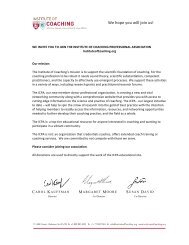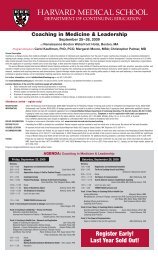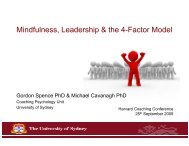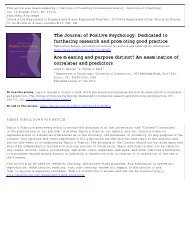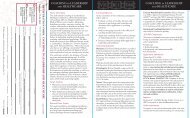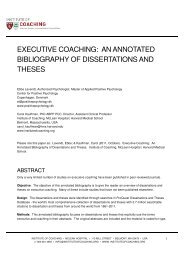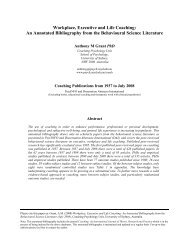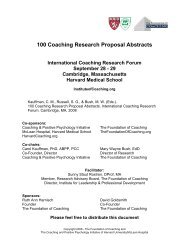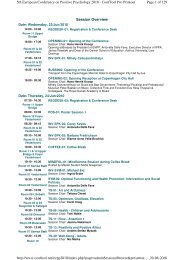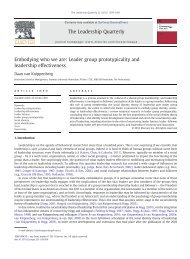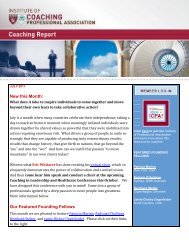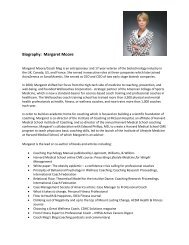Peer Tutoring and Coaching Program with College Students
Peer Tutoring and Coaching Program with College Students
Peer Tutoring and Coaching Program with College Students
- No tags were found...
You also want an ePaper? Increase the reach of your titles
YUMPU automatically turns print PDFs into web optimized ePapers that Google loves.
PEER TUTORING AND COACHING PROGRAM WITH COLLEGE STUDENTS:IMPLICATIONS FOR A POSITIVE AND HEALTHY INTEGRATION INUNIVERSITYAna Sara Carneiro Aires Ferreira Dissertation Integrated Master in Psychology School of Psychology University of Minho 2010 -‐ Approved by the Dissertation Committee -‐ Supervisor: Teresa Freire Assistant Professor School of Psychology, University of Minho This study was supported by a Graduate Student Fellowship from Institute of <strong>Coaching</strong>, affiliated <strong>with</strong>McLean Hospital, a Harvard Medical School Affiliate.iii
Index 1. INTRODUCTION ......................................................................................................................... 9 1.1. Young adults <strong>and</strong> <strong>College</strong> Context ....................................................................................... 9 1.2. The Importance of Intervening in <strong>College</strong> ........................................................................ 10 1.3. Characterization of the <strong>Peer</strong> <strong>Tutoring</strong> <strong>and</strong> <strong>Coaching</strong> Project ........................................ 14 1.3.1. Theoretical framework .................................................................................................. 14 1.3.2. The Project’s Structure .................................................................................................. 15 1.3.3. The Project: Functioning ............................................................................................... 17 1.4. Aims of the study ................................................................................................................. 21 2. METHOD .................................................................................................................................... 23 2.1. Participants .......................................................................................................................... 23 2.2. Instruments .......................................................................................................................... 24 2.2.1. Self-report Instruments .................................................................................................. 24 2.2.2. Semi-structured Interview ............................................................................................. 26 2.3. Procedure ............................................................................................................................. 26 2.4. Data Analysis ....................................................................................................................... 27 3. RESULTS .................................................................................................................................... 28 3.1. Tutors <strong>and</strong> Tutees ............................................................................................................... 28 3.1.1. First moment of evaluation - pre test ............................................................................. 28 3.1.2. Second moment of evaluation – post test ...................................................................... 29 3.1.3. Differences between moment 1 <strong>and</strong> moment 2 - Tutees ............................................... 31 3.1.4. Differences between moment 1 <strong>and</strong> moment 2 - Tutors ................................................ 32 3.1.5. Impact of Quality of Life, Life Satisfaction <strong>and</strong> Psychological Well-being in Academicadaptation ...................................................................................................................................... 33 3.2 Coaches ...................................................................................................................................... 34 4. DISCUSSION .................................................................................................................................. 36 5. REFERENCES ................................................................................................................................ 41 vii
promotion of positive variables. In fact, in the last years, there is an increased concerned about health<strong>and</strong> well-being of colleges students (Warwick, Statham & Aggleton, 2008).The introduction of the World Health Organization’s definition of health can be considered adeterminant factor for an increasingly positive perspective of the individual. In fact, this organizationstates that “health is a state of complete physical, mental <strong>and</strong> social well-being <strong>and</strong> not merely theabsence of disease or infirmity” (WHO, 1948), which extended the scope of action of healthprofessionals. This definition looks at the individual as a whole <strong>and</strong> considers that being healthy is notthe opposite of not being ill. It involves a holistic perspective of well-being <strong>with</strong> personal <strong>and</strong> socialresources, <strong>and</strong> physical capabilities.With this definition, WHO developed the concept of “Healthy Cities”, cities in whichgovernments actively promote their populations’ health <strong>and</strong> well-being. Similar to this movement,there is an international organization of Healthy <strong>College</strong>s, which Lancaster University (Engl<strong>and</strong>) is thepioneer. According to Escolme <strong>and</strong> colleagues (cit in Warwick, Satham & Aggleton, 2008), there aresome fundamental reasons why colleges must promote their students’ health <strong>and</strong> well-being. Theseauthors state that the reasons include: students’ feelings of well-being <strong>and</strong> belonging to a college canhave a positive impact in their achievement; it is essential to include the promotion of health <strong>and</strong> wellbeingin order to provide greater learning opportunities; <strong>and</strong> also, since there are many negative factorsthat can influence students well-being <strong>and</strong> achievement, colleges must try to diminish the influence ofthese factors.In this line of research, two important variables are part of this positive perspective namelyHealth <strong>and</strong> Quality of Life. How the students perceive their health status <strong>and</strong> quality of life <strong>and</strong> whatcan be done to promote the development of these states in students are fundamental questions thatneed to be addressed.Young adults are a population that is increasingly being studied by investigators in severalareas, including health <strong>and</strong> lifestyles; however, these studies are frequently related to their riskbehaviors, thus there is little information related to students’ health in colleges. Nevertheless, theexistent data alerts for a preoccupying reality. When compared to their working peers, universitystudents have poorer health (Stewart-Brown, Evans, Patterson, Petersen, Doll, Baldig & Regis, 2000).Moreover, when considering health-related problems <strong>and</strong> risk behaviors more specifically related tocollege students <strong>and</strong> their lifestyles, it is evident some alerting data, such as alcohol consumption,mainly in what concerns heavy episodic or binge drinking, poor nutrition habits, risk sexual behaviors,drug use, <strong>and</strong> the most common, stress-related disorders (fatigue, hypertension, headaches, depression,anxiety) (cf. Grace, 1997). The latter are the result of multiple stressors present in college students,namely exams, public presentations, interpersonal relationships <strong>and</strong> transition to a different householdin some cases (Grace, 1997).As for Quality of life, it has been defined by the World Health Organization (WHO, 1995) asthe “individuals' perceptions of their position in life in the context of the culture <strong>and</strong> value systems in11
which they live <strong>and</strong> in relation to their goals, expectations, st<strong>and</strong>ards <strong>and</strong> concerns”. Studies regardingquality of life in college students demonstrate that it is related to academic achievement <strong>and</strong> can beinfluenced by academic, social, financial <strong>and</strong> personal stressors that are common to the academicenvironment (e.g. Roberts & Clifton, 1992; Rozmus, Evans, Wysochansky & Mixon, 2005). Also, astudy <strong>with</strong> first year students revealed that these individuals rate both their quality of life <strong>and</strong> self-ratedhealth lower than their working peers (Vaez, Kristenson & Laflamme, 2004).Besides Health Psychology, Positive Psychology can also give an important contribution to thefocus of intervention in positive variables related to the individuals. There are multiple definitions ofpositive psychology, all including the focus on promoting <strong>and</strong> developing positive characteristics <strong>and</strong>strengths that can contribute to optimal functioning in the lives of individuals. These concepts can besummarized in three important variables: positive subjective experience (such as positive emotions),strengths of character <strong>and</strong> institutions that can help promote experiences <strong>and</strong> character (Kauffman,2009).This focus on the best of individuals can bring substantial gains at several levels, since it canplay an important role in individuals’ daily dem<strong>and</strong>s <strong>and</strong> difficulties, thus contributing to a betterresponsiveness. In this sense, Positive Psychology also tries to promote quality of life, as well as wellbeing.These interventions targeting to increase individuals’ well-being seem to be of particularrelevance. It has been demonstrated that it is possible to increase life satisfaction <strong>and</strong> psychologicalwell-being, <strong>and</strong> the promotion of positive emotions can improve cognitive, emotional <strong>and</strong> physicalareas of the individual (cf. Kauffman, Boniwell & Silberman, 2009).The attention given to positive concepts <strong>and</strong> promotion rather than prevention appears to be atendency in most scientific domains. In fact, Psychology is changing from a focus in pathology <strong>and</strong>disorder to a concern <strong>with</strong> building positive qualities (Seligman & Csikszentmihalyi, 2000), similar tohealth professionals, who started to emphasize the promotion of health instead of illness prevention. Itis in this context that positive psychology <strong>and</strong> positive development are emerging, as a main issue tobe considered for improving students’ achievement.Health Psychology <strong>and</strong> Positive Psychology seem to have some common ground. In fact,Positive Psychology has contributed significantly to the comprehension of many questions related tohealth promotion. In the beginning, health promotion was dedicated to the study of the impact ofhealth messages based in fear <strong>and</strong> vulnerability; Positive Psychology brought a new insight on thisquestion. Studies have shown that positive variables have a significant role in the acceptance of healthmessages <strong>and</strong> behavior change (cf. Taylor & Sherman, 2004). For example, a study <strong>with</strong> collegestudents concluded that those that were more optimistic were more receptive to negative informationabout health risks (Aspinwall & Brunhart, 1996, cit in Taylor & Sherman, 2004). This can beunderstood considering that individuals can use their positive experiences <strong>and</strong> affective states asresources when they need.12
Positive psychology emphasizes <strong>and</strong> values subjective experiences, namely well-being,contentment <strong>and</strong> satisfaction <strong>with</strong> the past, flow <strong>and</strong> happiness in the present, hope <strong>and</strong> optimismthrough the future (Seligman & Csikszentmihalyn, 2000).Life satisfaction is defined as a global construct of satisfaction that each individual makes himor herself (Pilcher, 1998). In this sense, it is a global, subjective measure based on personal judgmentthat involves several well-being domains, such as health, vigor <strong>and</strong> mood (Pilcher, 1998). LifeSatisfaction seems to be related to a wide range of emotions such as anger, depression <strong>and</strong> anxiety, aswell as health <strong>and</strong> sleeping habits (cf. Pilcher, 1998). A review of studies made <strong>with</strong> severalpopulations of different countries <strong>and</strong> across years reveled that life satisfaction seems to maintain itsstability in different cohorts <strong>and</strong> cultures (Biener & Suh, 1997, cit in Seco, Casimiro, Pereira, Dias &Custódio, 2005).In what concerns psychological well-being, this concept also relates to the necessity of focusingon more positive variables when considering interventions. In early works, psychological well-beingwas associated <strong>with</strong> the study of the perception individuals have of their mental health in order topromote psychological well-being. Later, it has been associated <strong>with</strong> stress studies <strong>and</strong> their concept ofadaptation. For example, psychological well-being is mentioned in the works of Lazarus <strong>and</strong> Folkman,(cit in Lima, 2003), when considering stress adaptation the objective is to develop coping strategies todeal <strong>with</strong> stress in order to restore or maintain the perception of well-being.In summary, college students can be considered a specific group <strong>with</strong> different necessities fromother populations. They are confronted <strong>with</strong> several dem<strong>and</strong>s which can alter significantly their livesthus having an impact in their general well-being. This indicates the importance of intervening in thiscontext, considering the specificities <strong>and</strong> competences students must develop to adapt <strong>and</strong> integratecollege, mainly for first-year students. Considering this, the program “<strong>Peer</strong> <strong>Tutoring</strong> <strong>and</strong> <strong>Coaching</strong>”(Freire, 2009) was developed aiming to assist in freshmen integration <strong>and</strong> the promotion of severalinterpersonal <strong>and</strong> academic competences. The present study intends to evaluate the program in termsof its impact in the life of students in college context. The project considers that first year students canbe assisted by older students since the latter have more knowledge about the college’s functioning <strong>and</strong>how to cope <strong>with</strong> some of the challenges these new experiences may entail.The benefits of the “<strong>Peer</strong> <strong>Tutoring</strong> <strong>and</strong> <strong>Coaching</strong>” program exceed simply the prevention ofpotential problems in adaptation to college. There is a focus in a positive perspective, sustained in thecontext of variables that promote the development of positive characteristics in students <strong>and</strong>, therefore,a positive <strong>and</strong> healthy integration in this life context – college. The way students cope <strong>with</strong> this newchallenges can determine the way they will perform along the years they are in the university, as interms of academic achievement as in terms of personal <strong>and</strong> social tasks related to this life context.13
1.3. Characterization of the <strong>Peer</strong> <strong>Tutoring</strong> <strong>and</strong> <strong>Coaching</strong> Project1.3.1. Theoretical frameworkIn addition to the aspects mentioned previously, the “<strong>Peer</strong> <strong>Tutoring</strong> <strong>and</strong> <strong>Coaching</strong>” project(Freire, 2009) also considers Vygotsky’s perspective on peer learning processes. In fact, the program<strong>and</strong> its potential impact can be understood considering Vygotsky general theory <strong>and</strong> the concept of“Zone of Proximal Development” (ZPD) in particular. This author stated that knowledge starts bybeing interpersonal before it is intrapersonal, hence the importance of peer collaboration in learningprocesses, through which individuals develop skills <strong>and</strong> competences (Mynard & Almarzouqi, 2006).ZPD can be defined as “the distance between the actual developmental level as determined byindividual problem solving <strong>and</strong> the level of potential development as determined through problemsolving under adult guidance or in collaboration <strong>with</strong> more capable peers’’ (Vygotsky, 1978, p.86).This concept considers processes that are initiating its formation <strong>and</strong> their development is in course.Similarly, the context of a peer relationship is the base to development of knowledge as well as skills<strong>and</strong> capacities.According to the objectives of the project, each student integrated in the project, has thepossibility to grow <strong>and</strong> develop their competencies <strong>and</strong> skills, in line <strong>with</strong> Csikszentmihalyi’sperspective about flow experience (Csikszentmihalyi, 1991). By participating in this project, studentshave the opportunity to improve their levels of expertise, engagement <strong>and</strong> involvement, necessary tothe emergence of positive experiences in academic contexts <strong>and</strong> trajectories. Consequently, theirexperience as students will be more positive as well as a source of individual complexity, which inturn can cause students to be available to individual <strong>and</strong> social development. Moreover, by havingdifferent roles, students that stay in the project for more than one edition have the opportunity to beengaged progressively in more complex activities <strong>and</strong> challenges.This program can have several benefits for both tutees <strong>and</strong>, tutors <strong>and</strong> coaches. For tutees, it ispossible to promote a global <strong>and</strong> successful integration in the academic context as they acquire skillsthat allow them to deal <strong>with</strong> the dem<strong>and</strong>s of the setting at personal, academic <strong>and</strong> social levels. Fortutors <strong>and</strong> coaches, it is important to consider processes of learning <strong>and</strong> formation through activeinvolvement <strong>and</strong> responsibility of the role performed. The differentiation between tutors <strong>and</strong> coachesis very important <strong>and</strong> plays a role in motivating tutors for an increased involvement in the project. Toachieve these different roles contribute for an increase in personal development <strong>and</strong> self-complexity,<strong>with</strong> the acquisition of new skills when facing new challenges (Freire, Fonte e Lima, 2007). And sinceit is a peer program, being in a peer relationship is also beneficial for all participants. It allows them tolearn from each other, to build a relationship based on equality where personal experience is valued.Participants’ perspective about the advantages of the program is very similar to the potentialbenefits mentioned above. Both tutors <strong>and</strong> tutees referred significant gains due to participation in the14
project, mainly academic, social <strong>and</strong> communicative, which they perceived as actively contributing totheir personal <strong>and</strong> academic life (Freire & Ferreira, in preparation). This specific study only includedtutors <strong>and</strong> tutees but shows the importance of tutoring for tutors <strong>and</strong> tutees, <strong>and</strong> the increasedcomplexity of these processes, from tutoring to coaching. Furthermore, tutors <strong>and</strong> tutees mentionedbecoming more capable <strong>and</strong> socially involved, more integrated in academic context as well as animproved performance. Also, some participants stated that they developed several skills which will beused in their academic <strong>and</strong> professional future. All this emphasis in the development <strong>and</strong> improvementof competences demonstrates one of the main objectives of coaching – what we can do better (Thorn,McLeod & Goldsmith, 2007). Besides this, it was verified that the relationship between tutors <strong>and</strong>tutees was fundamental, which demonstrates the importance of a peer context in learning.1.3.2. The Project’s StructureThe main objective of this program is to promote new forms of support students <strong>with</strong> the finalpurpose of a successful academic integration <strong>and</strong> personal development. In this project, we considerthat academic success is not limited to curricular issues but involves several other variables concerned<strong>with</strong> personal <strong>and</strong> social dimensions.<strong>Students</strong> participating in this program have different roles depending on their status on theproject; they can be tutees, tutors or coaches. The foundation of this program is that students that areentering university for the first time (tutees) can be supported by older students (tutors) throughsessions where the objective is to respond to the tutees’ integration necessities in order to organizetheir new life pattern. Alternatively, tutors are supported by other students (coaches) that can helpthem to perform their tutor role through coaching sessions.<strong>Tutoring</strong> related to curricular subjects is not included in this program. The absence of this kindof curricular support is one of the specificities of this project when compared <strong>with</strong> similar programsimplemented in other University contexts (or educational contexts in general). The adoption of thisrule is in agreement <strong>with</strong> the project’s interpretation of academic success. In this perspective it isbelieved that students can improve their academic success through the development of broadercompetences <strong>and</strong> skills. It is this wide-ranging perspective about university life <strong>and</strong> academic successthat makes it an innovating way of promoting academic achievement.In this project, any student attending the first year of college can be tutee; on the contrary, to bea tutor it is necessary that some criteria be met since they will be performing a role that requires themto be responsible for a group of students. Tutors must be students attending at least the second year ofcollege. It is necessary to have academic success, available time to tutoring <strong>and</strong> motivation toaccomplish the role of tutor, sharing their strengths <strong>and</strong> competencies <strong>with</strong> their peers. After applyingfor tutors, students are called for individual interviews <strong>and</strong> selected. If they are selected to be tutors,they will have to attend a formation course of six hours aimed to develop specific knowledge about15
positive pro-social, group <strong>and</strong> relational behaviors, interpersonal communication skills, stressmanagement, communication competencies, among others, as well as learning about thecharacteristics <strong>and</strong> aims of the program itself. Acquiring these skills is fundamental for the goodfunctioning of tutoring sessions <strong>and</strong> for the development of the relationship between tutees-tutors <strong>and</strong>tutors-coaches. Alternatively, since tutors can be students from any course of the university, it is alsoimportant that they have this formation, which contains topics seldom included on their academiccurriculum (<strong>with</strong> the exception of psychology students), so that they are all prepared to perform tutor’srole.There are two types of tutors: tutors/co-tutors <strong>and</strong> coaches. On one h<strong>and</strong>, we have tutors thath<strong>and</strong>le directly tutees in groups of one tutor for a small group of tutees. Also, <strong>with</strong>in the tutor role,there is the role of co-tutors which means that, although having the required characteristics to be atutor, the student is not yet prepared to work alone <strong>with</strong> a group. He/she is instead paired <strong>with</strong> a tutor<strong>and</strong> together they conduct the tutoring session. In this case, learning by modeling is likewise anintentional tool in the learning process becoming relevant in the peer tutoring context. One the otherh<strong>and</strong>, coaches support tutors in their tutoring process. To be a coach, students need to have been tutorspreviously. This hierarchy is represented in the following 4-level structure:CoordinatorCoachTutorTuteeFigure 1: Hierarchy of the different roles participants have in the project In this structure, peer tutors are directly involved <strong>with</strong> tutees, engaging in peer tutoring sessionsaccording to structure <strong>and</strong> rules defined for functioning. In the next level we have coaches that areinvolved <strong>with</strong> tutors in coaching sessions. On the top of the hierarchy we have the coordinator, <strong>and</strong>other involved teachers, that are responsible for all the participants in the project, in this case ProfessorTeresa Freire. Considering the different possibilities of involvement across time, students can start astutees, continue as tutors <strong>and</strong> then become coaches, creating the opportunity for personal improvement16
<strong>and</strong> social involvement which can be an indicator of the impact of this program in their lives <strong>and</strong>personal development.The role of “coach” was introduced after some implementations of the project due to thenecessity of introducing new challenges <strong>and</strong> more complex tasks for participants that were in theprogram as tutors for more than one year. Underlying this addition to the program is the idea that, byparticipating in the project, we believe that students become more competent <strong>and</strong> self-complex, <strong>and</strong>thus become also more competent in this peer collaboration process. According to this, <strong>and</strong>considering participants’ new expertise, they will be able to tutor tutors, improving tutoring to a newlevel of peer collaboration – peer coaching. This means that we can differentiate between the tutor thatdoes tutoring to the tutee, <strong>and</strong> the one that is tutoring other tutors. As tutors <strong>with</strong> more expertise, thesestudents have different <strong>and</strong> more complex skills comparing to a student that is tutoring for the firsttime.Within this perspective these tutors can share their experiences <strong>with</strong> first time tutors. So, inorder to differentiate this level of expertise in the tutoring process, the role of peer coaching emerged:skillful tutors tutoring first time tutors become peer coaches of these tutors <strong>and</strong> the process becomesthe one of peer coaching. Coaches’ training is their own experience in the project <strong>and</strong> the experienceof had been a tutor in previous editions, being now supervised by the staff of the project (coordinator<strong>and</strong> all teachers involved).1.3.3. The Project’s FunctioningThe tutoring session has the duration of approximately between 60 to 90 minutes, being runweekly or fortnightly. This time of duration for each session is due to the fact that sessions are made ingroups (from 3-5 students) so enough time is needed for all students to participate <strong>and</strong> interact. Aftereach session, both tutors <strong>and</strong> tutees discuss their accordance <strong>with</strong> the topics worked in the session <strong>and</strong>agree about the theme for the following sessions. Although tutors have a plan for each session, theycan include new topics that have become pertinent for the tutee in the time between sessions that werenot possible to include in the session plan. Also, the frequency of the sessions can be negotiatedbetween tutors <strong>and</strong> tutees according to their needs, which helps to keep tutees motivated to attendsessions.Examples of themes discussed during sessions include underst<strong>and</strong> the college’s official website<strong>and</strong> the services available online, underst<strong>and</strong> the library’s functioning <strong>and</strong> services, time management,stress <strong>and</strong> study management, among others. In every tutoring session each tutee needs to fill a formalform concerning “Things I want to work in the next session”. This is given to the tutor one weekbefore the session to work on it. If tutees need a different subject that wasn’t predicted, it is supposedthat tutors have the resources <strong>and</strong> the experience to find about that specific subject or to who theyshould ask for help.17
Tutees are also required to have a proactive <strong>and</strong> responsible behavior toward their tutors <strong>and</strong>sessions. The tutee is not conceived as a recipient of this process but an active element that needs tocontribute to the usefulness of the process.In a monthly structure the tutor has meetings <strong>with</strong> his/her peer coach (another student) in orderto discuss how the sessions are going on, the positive aspects <strong>and</strong> negative ones, <strong>and</strong> suggestions tobetter strategies for tutors acting <strong>with</strong> tutees. Meetings between coaches <strong>and</strong> tutors (that becomecoachees in this specific peer relation) occur in a more flexible structure, being defined every timetutors or coaches decide about its need.The participants’ different roles also reflect two different interventions in this project: peertutoring <strong>and</strong> peer coaching.In this project, peer tutoring occurs in the tutee-tutor relationship. The history of peer tutoringcan be traced to ancient civilizations like the Greeks, although their concept was limited to the passingof information from the most able <strong>and</strong> experienced to the least able (Topping, 1996). Gradually, it wasunderstood that the relationship between tutor <strong>and</strong> tutee is a reciprocal one. Considering this althoughthere are multiple definitions of peer tutoring, in essence it can be defined as a process in which aparticipant tutors his/her peers <strong>and</strong> learns <strong>with</strong> that experience (Falchikov, 2001; Gordon, 2005).Although it is a reciprocal process, Topping (1996) highlighted that there are specific roles assumedby the participants: tutors <strong>and</strong> tutees. A peer tutoring project is easier to implement, it seems to bemore effective <strong>and</strong> promotes social interactions among peers (Kohler & Greenwood, 1990).The application of peer tutoring to an academic context is widely spread <strong>and</strong> diverse, varying inpurpose <strong>and</strong> structure; however they are mostly limited to academic subjects <strong>and</strong> in a classroomenvironment. On the contrary, this project includes peer tutoring in a broader perspective - theintegration in university in order to optimize the role of student <strong>and</strong>, indirectly its academic success.Several benefits of peer tutoring have been reported for tutors <strong>and</strong> tutees related to bothacademic <strong>and</strong> non-academic outcomes. These include learning academic skills, acquire competencesin several academic areas <strong>and</strong> have a more positive attitude towards learning, develop a more positiveself-image, higher levels of motivation, social skills, among others (Gordon, 2005). For tutors, thebasic concept is learning by teaching – besides tutoring sessions themselves, the necessary preparationof sessions can increase attention <strong>and</strong> motivation as well as promote reviews of the existingknowledge <strong>and</strong> experience. As for tutoring sessions, the processes of simplification, clarification <strong>and</strong>exemplification can involve additional cognitive challenges for tutors (Topping, 1996). As for tutees,it can have an impact on their learning to be more active, interactive <strong>and</strong> participative, as well asattitudinal gains, such as commitment, self-esteem, self-confidence <strong>and</strong> greater empathy <strong>with</strong> others(Topping, 1996). Also, tutees recognize that since their tutors have gone through the same experiencethey are more capable of underst<strong>and</strong>ing them (Santee & Garavalia, 2006).<strong>Coaching</strong> Psychology is a relative recent discipline <strong>and</strong> can be defined as the discipline “… forenhancing well-being <strong>and</strong> performance in personal life <strong>and</strong> work domains…” (Grant & Palmer, cit in18
could benefit from the development of teachers’ competences. Nowadays, it is widely include inmultiple contexts <strong>and</strong> participants, namely in health, corporations, schools, universities, as well asseveral fields including nursing <strong>and</strong> medical education, patient education, education, staffdevelopment, counseling effectiveness, among others (cf. Parker, Hall & Kram, 2008).The main characteristic of peer coaching, as mentioned before is the context of a peerrelationship <strong>and</strong> its unique contribution is “the inherent mutuality <strong>and</strong> reciprocity of the process”(Parker, Hall, <strong>and</strong> Kram, 2008, pp 490). Both coach <strong>and</strong> coachee are learners in this process, thus thenature of their relationship is crucial to the success of coaching. Characteristics of the relationship thatcontribute to positive outcomes in coaching include a climate of trust <strong>and</strong> support, feedback <strong>and</strong>conversation, among others (Parker, Hall, <strong>and</strong> Kram, 2008).It is well known the influence that peers have in individuals’ development, just as mentionedbefore <strong>with</strong> the vygotskyan perspective. Thus, bringing peers relationships to coaching can haveseveral advantages. First of all, it allows the development of feelings of support; it does not havecertain boundaries like other relationships (e.g. teacher-student), <strong>and</strong> feedback is provided <strong>with</strong>outevaluative purposes (e.g. Parker, Hall, <strong>and</strong> Kram, 2008), giving a notion of equality in the relationship.A successful peer relationship tends to have some common aspects such as the exchange ofinformation or knowledge; the exchange of roles (in a way that learning occurs for both participants);<strong>and</strong> the exchange of rank (i.e. maturity, expert role), in which both participants alternate in their expertrole (Maitl<strong>and</strong>, 2006).Although few studies have been conducted about peer coaching (Sekerka & Chao, 2003), itappears that this research domain is increasing. This tendency is probably due to the application ofpeer coaching to new <strong>and</strong> relevant contexts, because there is an acknowledgement that learning is asocial process <strong>and</strong> is influenced by peers (Ladyshewsky, 2006). For example, in a peer coachingprogram for nurse students, senior students accompanied juniors in their first contact <strong>with</strong> patients, asituation that can be a very stressful <strong>and</strong> anxious. Junior students reported a diminution in anxietylevels <strong>and</strong> considered coaching benefic for them. Senior students also found coaching benefic,allowing them to practice leadership skills (Broscious, & Saunder, 2001 cit in Newham-Kanas,Gorczynski, Morrow & Irwin, 2009). Other study tried to evaluate the impact of a peer coachingprogram for diabetics in behavioral change <strong>and</strong> concluded that this type of coaching is effective(Joseph, Griffin, Hall & Sullivan, 2001, cit in Newham-Kanas, Gorczynski, Morrow & Irwin, 2009).Considering these issues, it is perceptible that coaching psychology <strong>and</strong> peer coaching have along way ahead. It is fundamental to explore relations between variables present in coaching programsto develop methodologies <strong>and</strong> assessment instruments in order to underst<strong>and</strong> the underlying processesinvolved.In our perspective these processes are related to these three main conceptual approaches asbeing presented in this project: positive psychology, coaching psychology <strong>and</strong> health psychology. It istheir interrelation that creates an innovative way of promoting skills <strong>and</strong> competencies among20
students, making them personally improved, academically involved <strong>and</strong> socially committed (Freire,Fonte & Lima, 2007; Freire, Lima & Fonte, 2009). These concepts are express in the structure <strong>and</strong>way the program works, based on peer collaboration <strong>and</strong> simultaneously in the different roles taken bystudents along time. Each role has specific aims, but all together they contribute to the development ofsuccessively higher skills, making students progressively able to face new <strong>and</strong> complex challenges inacademic settings, or along their career trajectories considering a life-span perspective (Parker, Hall,<strong>and</strong> Kram, 2008).Furthermore, besides tutoring <strong>and</strong> coaching sessions, tutors <strong>and</strong> coaches must create supportmaterials, individually <strong>and</strong> in groups. Individually, each tutor <strong>and</strong> coach develop materials that supporttheir tutoring sessions, <strong>and</strong> these materials should be available for all the elements of the program atthe end of school year, including them in their written report (delivered at the end of the project’sedition) along <strong>with</strong> sessions plans as well as new suggestions for next tutoring <strong>and</strong> coaching projects.Despite this individual contribution for the group, tutors <strong>and</strong> coaches work in group <strong>with</strong> thepurpose of developing more generic materials for the program, such as, an ethic code, production ofdivulgation materials <strong>and</strong> elaboration of rules, among others. These tasks appeal to their sense ofcommitment <strong>and</strong> responsibility in this process. Together, students learn <strong>and</strong> teach, share <strong>and</strong> create,being aware of their power as persons that are responsible for others, even when they are peers.The role of tutor is recognized by the university as an institutional role being formally insertedin the final diploma of competences of the student. This aspect constitutes one of the reasons to jointhe project, to be engaged <strong>and</strong> to not drop out of the project.1.4. Aims of the studyConsidering the specificities, characteristics <strong>and</strong> objectives of this program, we believe that it isessential to objectively assess the impact that the involvement in this project has for the intervenientparts. As presented in the International <strong>Coaching</strong> Research Forum (Kauffman, Russell, & Bush, 2008)by Professor Teresa Freire, there are several sub-projects that can be considered for investigationbased in this peer coaching program <strong>with</strong> college students. Nevertheless, specifically for this researchwe are aimed to attend questions related to the impact of the involvement in peer tutoring <strong>and</strong>coaching program in positive variables, namely quality of life, life satisfaction <strong>and</strong> psychological wellbeing.We also intend to verify if these positive outcomes can influence the adaptation to college, thisadaptation measured in terms academic experiences. In a larger scope, we intend to analyze if thisprogram contributes to the promotion of a healthy <strong>and</strong> positive integration in the university context, aswell as to an individual <strong>and</strong> social positive development for all intervenient parts.21
We are questioning if there will be differences before <strong>and</strong> after participation in the program fortutees <strong>and</strong> tutors, as well as if there will be differences between them in these two moments ofevaluation. Considering the outcome variables defined, we evaluated both tutors <strong>and</strong> tuteesconsidering their quality of life, life satisfaction <strong>and</strong> psychological well-being. Furthermore, wequestion if these outcome variables (quality of life, life satisfaction <strong>and</strong> psychological well-being) canpredict academic experience variables related to their adaptation. As for coaches, we question whatimportance role of coach had from their perspective as well as if they evaluate it as having asignificant impact in them.22
2. METHOD2.1. ParticipantsParticipants are all the students that integrate the project “<strong>Peer</strong> <strong>Tutoring</strong> <strong>and</strong> <strong>Coaching</strong>” ofUniversity of Minho for the academic year of 2009/2010, which includes tutees (67.2%, n=39) <strong>and</strong>tutors (32.8%, n=19) in a total of 58 participants, as well as coaches, in a total of 7 participants.Coaches were 6 females <strong>and</strong> 1 male <strong>with</strong> ages between 20 <strong>and</strong> 21 years old, all are third year studentsfrom Psychology.As for tutors <strong>and</strong> tutees, 81% (n=47) are female <strong>and</strong> 19% (n=11) are male. Their ages variesbetween 17 <strong>and</strong> 48 years old, <strong>with</strong> a mean of 19.5 years old (SD=4.3).The majority of participants were graduating in Psychology (81%, n=47). As for the remaining,2 (3.4%) were graduating in Communicational Sciences, 2 (3.4%) in Law, 2 (3.4%) in InternationalRelationships, 1 (1.7%) in Biomedical Engineering, 1 (1.7%) in Informatic Engineering, 1 (1.7%) inApplied Foreign Languages, 1 (1.7%) Optometric Sciences <strong>and</strong> 1 (1.7%) in Biological Engineering.A discriminated characterization of participants by their roles is in table 1.Tutorsn=19Tuteesn=39SexMales 21.1% (n=4) 17.9% (n=7)Females 78.9% (n=15) 82.1% (n=32)Psychology 84.2% (n=16 79.5% (n=31)Communication Sciences 5.3% (n=1) 2.6% (n=1)Law5.1% (n=2)Biological Engineering2.6% (n=1)Course Applied Foreign Languages2.6% (n=1)Optometric Sciences2.6% (n=1)International Relations5.1% (n=2Biomedical Engineering 5.3% (n=1)Informatic Engineering 5.3% (n=1)1 st 100% (n=39)2 nd 68.4% (n=13)Year3 rd 5.3% (n=1)4 th 5.3% (n=1)5 th 5.3% (n=1)Living arrangementsOutside household 52.3% (n=10) 56.4% (n=22)Household 47.7% (n=9) 43.6% (n=17)Age M= 20 (SD=1.7) M= 19.1 SD=.39Table 1: Socio-demographic characterization of the participants by subgroups (tutors <strong>and</strong> tutees)23
2.2. Instruments2.2.1. Self-report InstrumentsHealth-related variablesTo evaluate health variables, it was used the “Questionário socio-demográfico e clínico” [Sociodemographic questionnaire] (Maia e Seabra, 2003), which also included demographic information.This questionnaire comprises health problems, namely sleep, eating, gastrointestinal, digestive <strong>and</strong>respiratory problems, as well as some risk behaviors, such as smoking, alcohol consumption <strong>and</strong>coffee consumption. Answers were given in a dichotomous format (yes/no). It was also included aquestion about living conditions of participants, specifically if they are living <strong>with</strong> their families ornot.Quality of lifeIn order to evaluate quality of life it was used the WHOQOL-Bref (WHO, 1995; Portugueseversion of Vaz Serra et al, 2006). This is a general measure that considers the subjective perspective ofthe individual’s quality of life. It is possible to use this measure <strong>with</strong> both clinical <strong>and</strong> nonclinicalpopulations. The WHOQOL-Bref is an abridged version of the WHOQOL-100; the necessity ofhaving a reduced version was related to the time of administration of the WHOQOL-100.The Portuguese version of this questionnaire has 26 items in a 5-point scale. A general scale canbe calculated <strong>with</strong> two of the items that are broader <strong>and</strong> refer to general perception of quality of life<strong>and</strong> general perception of health. The remaining 24 items are divided in four domains: physical (e.g.pain, energy, sleep), psychological (e.g. positive <strong>and</strong> negative feelings, concentration, self-esteem),social (e.g. personal relationships, support) <strong>and</strong> environmental (e.g. security, health care, leisure).The validation of this instrument for the Portuguese population reveled acceptable values foradministration. Internal consistency demonstrated Cronbach’s alpha values of .92 for all 26 items, .79for the four domains of the instrument, .87 in Physical Domain, .84 in Psychological Domain, .64 inSocial Domain, <strong>and</strong> .78 in Environmental Domain. The Social Domain had the lowest value, whichthe authors justify considering the number of items this domain has (3).Psychological well-beingTo evaluate psychological well being it was used the Psychological Well-Being Scale (Bizarro,1999). This scale has 28 items in a 6-point scale, organized in 5 sub-scales: Anxiety, which includescomplaints normally associated <strong>with</strong> anxiety; Negative Cognitive-emotional, which evaluatescognitive <strong>and</strong> emotional aspects of psychological well-being that are more negative; Social Supportwhich includes people that the individual can count on; Competencies Perception, which evaluates the24
individuals’ competences in general as well as related to school <strong>and</strong> interpersonal competences; <strong>and</strong>Positive Cognitive-emotional which evaluates cognitive <strong>and</strong> emotional aspects of psychological wellbeingthat are more positive.In addition to the 5 sub-scales, it is also possible to obtain a total score of well-being. Thequestionnaire assesses of psychological well-being considering two domains: well-being as absence ofindexes of difficulties (sub-scales anxiety <strong>and</strong> negative cognitive-emotional) <strong>and</strong> well-being as thepresence of positive factors or resources (sub-scales social support, competencies perception <strong>and</strong>positive cognitive-emotional).In what concerns psychometric characteristics, subscales present fidelity values between .85 <strong>and</strong>.90 (Cronbach’s alpha) <strong>and</strong> a value of .93 (Cronbach’s alpha) for total scale (Bizarro, 1999).Life SatisfactionTo evaluate Life satisfaction it was used the Life Satisfaction Scale (Diener, Emmons, Larsen &Giffin, 1985; adapted for Portuguese population by Neto, Barros & Barros, 1990). This scale has 5items in a 5-point Likert scale. Total score can range from 5, which corresponds to a low lifesatisfaction, to 25, which corresponds to a great life satisfaction.In original version was validated <strong>with</strong> a sample of college students <strong>and</strong> reveled an internalconsistency of .87 (Cronbach’s alpha). The Portuguese validation was also <strong>with</strong> a sample of collegestudents <strong>and</strong> obtain an internal consistency of .77 (Cronbach’s alpha).<strong>College</strong> Adaptation<strong>College</strong> adaptation was measured by the Questionnaire of Academic Experiences (QVA-r -Almeida, Ferreira & Soares, 1999). This self-report questionnaire aims to evaluate the personal,relational <strong>and</strong> institutional dimensions of students’ adaptation to the academic context. Thisquestionnaire was constructed specifically for Portuguese students <strong>and</strong> has 60 items in a 5-point LikertScale. These items are grouped in 5 dimensions: personal, interpersonal, career, study <strong>and</strong>institutional. Personal dimension to items related to self <strong>and</strong> physical, psychological well-beingperceptions (α=.87). The Interpersonal dimension includes peer relationships <strong>and</strong> involvement inextracurricular activities (α=.86). Career dimension refers to the adaption to the course <strong>and</strong> careerperspectives (α=.91). Study dimension includes the individual’s study competences, time management<strong>and</strong> utilization of academic resources (e.g. library) (α=.82). Institutional dimension refers to theinterest about the institution <strong>and</strong> the perception of quality of services <strong>and</strong> structures (α=.71).25
2.2.2. Semi-structured Interview<strong>Peer</strong> <strong>Coaching</strong> Variables<strong>Peer</strong> <strong>Coaching</strong> <strong>and</strong> its impact were evaluated through a semi-structured interview for coaches. Ithad near 10 questions concerning reasons to join, to continue in the project <strong>and</strong> to have chosen to be acoach; general evaluation of the role <strong>and</strong> comparison <strong>with</strong> other roles in the project, impact of the rolein terms of competences’ development, academic achievement <strong>and</strong> general quality of life, well-being<strong>and</strong> life satisfaction. In the end it was included a general question about the participants course in theproject <strong>and</strong> what gains were associated <strong>with</strong> long-term participation.2.3. ProcedureParticipants were all tutors, tutees <strong>and</strong> coaches participating in the peer coaching program in theacademic year of 2009/2010. <strong>Students</strong> participated voluntarily in the program <strong>and</strong> were offered amaterial compensation. Considering the different roles performed in the project, three groups wereformed to conduct the analysis: tutees, tutors <strong>and</strong> coaches. Data from tutors <strong>and</strong> tutees were collectedbefore <strong>and</strong> after tutoring sessions began while coaches’ data were collected after coaching sessionsended.In relation to data collection, it was used different methodologies considering the subgroups.For tutors <strong>and</strong> tutees it was used self-report measures which evaluated quality of life, psychologicalwell-being, life satisfaction, health-related variables <strong>and</strong> academic achievement. In addition to this, itwas also included socio-demographic measures in order to consider possible relevant information,such as age, sex, course, place of residence during classes. Alternatively, we believe to be important toconsider information related to whether the participant is living (or not) in his/her household, since itis frequent for students to leave their houses when entering higher education. In what concernscoaches, they were interviewed after the end of coaching sessions, using a semi-structured interviewspecifically created for this study.Considering the different type of data collected, results presentation is divided in two parts – thefirst one <strong>with</strong> quantitative data from tutors, tutees in a pre-test <strong>and</strong> post-test design; the second partpresents qualitative data post-test from coaches.In post test analysis we had an experimental mortality rate of about 14%, corresponding to 8participants, from the group of tutees. Participants that weren’t evaluated in the second moment wereexcluded from analysis.26
2.4. Data AnalysisTo analyze quantitative data it was used SPSS Software (version 17.0). Comparisons betweentutees <strong>and</strong> tutors both in pre <strong>and</strong> post measures as well as comparisons in tutees <strong>and</strong> tutors from pre topos test were conducted <strong>with</strong> nonparametric statistic given that the number of participants was small;it was used Mann-Whitney Tests for inter-subjects differences <strong>and</strong> Wilcoxon Tests for intra-subjectsdifferences. In order to test the potential impact of the variables considered to be the outcome of theproject’s impact (quality of life, life satisfaction <strong>and</strong> psychological well-being), it was utilized amultiple regression analysis; in this case we used parametric statistic seeing as the total number ofparticipants (tutors <strong>and</strong> tutees) is considerable <strong>and</strong> data was normally distributed.To analyze qualitative data collected <strong>with</strong> semi-structured interviews <strong>with</strong> coaches it was usedcontent analysis procedure. Firstly, interviews were transcribed <strong>and</strong> the materials were organized <strong>and</strong>prepared for analysis. A floating reading was made <strong>and</strong> subsequently the registration units weredefined for each question in order to start the codification. After defining the units, we proceeded tocounting them <strong>and</strong> categorize them in more general categories (Weber, 1990).27
3. RESULTS3.1. Tutors <strong>and</strong> TuteesThe analysis of tutors <strong>and</strong> tutees’ data will be done considering moments of evaluation (pre <strong>and</strong>post test) <strong>and</strong> their specific role in the project (type of participation – tutor/tutee) in the variablesincluded in this study - health-related variables <strong>and</strong> outcome variables (quality of life, life satisfaction<strong>and</strong> psychological well-being).3.1.1. First moment of evaluation - pre testFirstly it will be presented results of health-related variables. In the first moment, correspondingto data collection before tutoring sessions began, descriptive statistics shows that the majority ofparticipants didn’t present neither risk behaviors nor major health problems in the last year, <strong>with</strong> theexception of caffeine consumption for tutors (57.9%, n= 11).Qui-squares tests showed that that isn’t any significant associations between tutors <strong>and</strong> tutess interms of health problems <strong>and</strong> risk behaviors.Descriptive data <strong>and</strong> chi-square results are summarized in tables 2 <strong>and</strong> 3.SleepproblemsEatingproblemsGastrointestinalproblemsDigestiveproblemsTuteesN= 39 (%)Yes 17 (43.6%) 5 (12.8%) 5 (12.8%) 4 (10.3%)No 22 (56.4%) 34 (87.2%) 34 (87.2%) 35 (89.7%)TutorsN= 19 (%)Yes 8 (42.1%) 6 (31.6%) 1 (5.3%) 4 (21.1%)No 11 (57.9%) 13 (68.4%) 18 (94.7%) 15 (78.9%)χ 2 .01 (p= .91) 2.92(p=.10).79 (p= .37) 1.25(p=.26)Table 2: Descriptive data <strong>and</strong> chi-square results of health problems for tutors <strong>and</strong> tuteesRegular smoking Regular drinking Regular caffeine consumptionTuteesN=39 (%)TutorsN=19 (%)yes 2 (5.1%) 11 (28.2%) 12 (34.3%)no 31 (79.5%) 24 (61.5%) 23 (59%)yes 1 (5.3%) 7 (36.8%) 11 (57.9%)no 18 (94,7%) 11 (57.9%) 8 (42.1%)χ 2 .01 (p=.90) .29 (p=.59) .81(p=.09)Table 3: Descriptive data <strong>and</strong> chi-square results of risk behaviors for tutors <strong>and</strong> tutees28
Subsequently, we proceeded to test differences between participants in moment 1 (pre test) inwhat concerns the variables considered outcome – quality of life, life satisfaction <strong>and</strong> psychologicalwell-being. It was used the non-parametric statistic test Mann-Whitney.Considering the study’s objective, we questioned if there are differences between tutors <strong>and</strong>tutees in the first moment of evaluation when considering general scales <strong>and</strong> subscales of the outcomevariables. Mann-Whitney tests revealed that this was not verified; we found no significant differencesbetween participants, although there are some marginal differences in terms of general quality of life<strong>and</strong> physical quality of life. Results are summarized in table 4.TutorsTutees Z p(N=19)Mean Rank(N=39)Mean RankGeneral 34.75 26.35 -1.86 .06 †Physical domain 35.16 26.74 -1.80 .07 †Psychological32.66 27.96 -1.00 .32Quality of Life domainSocial domain 25.82 29.15 -.74 .46Environmental32.55 28.01 -.97 .33domainLife Satisfaction General31.16 28.69 -.52 .60General 26.03 29.77 -.17 .87Cognitive-emotional 23.16 31.92 -.82 .41positive subscaleSocial support28.92 29.04 -1.89 .59PsychologicalWell-BeingsubscaleCompetences28.37 29.32 -.03 .98perception subscaleCognitive-emotional 24.84 30.38 -.20 .84negative subscaleAnxiety subscale 27.50 28.26 -1.21 .23Table 4: Differences between tutors <strong>and</strong> tutees in moment 1† p
SleepproblemsEatingproblemsGastrointestinalproblemsDigestiveproblemsTuteesN= 39(%)TutorsN= 19(%)Yes 16 (51.6%) 6 (19.4%) 3 (9.7%) 5 (16.1%)No 15 (18.4%) 25 (80.6%) 28 (80.6%) 26 (83.9%)Yes 6 (31.6%) 2 (10.5%) 1 (5.3%) 1 (5.3%)No 13 (68.4) 17 (89.5%) 18 (94.7%) 18 (94.7%)χ 2 1.92(p=.16).69 (p= .41) .31(p= .58) 1.32 (p= .25)Table 5: Descriptive data <strong>and</strong> chi-square results of health problems for tutors <strong>and</strong> tuteesRegular smoking Regular drinking Regular caffeine consumptionTutees yes 3 (9.7%) 7 (22.6%) 13 (41.9%)N=39 (%) no 28 (90.3%) 24 (77.4%) 18 (58.1%)Tutors yes 0 8 (42.1%) 9 (47.4%)N=19 (%) no 19 (100%) 11 (57.9%) 10 (52.6%)χ 2 1.96 (p= .16) 2.14 (p= .14) .54 (p= .46)Table 6: Descriptive data <strong>and</strong> chi-square results of risk behaviors for tutors <strong>and</strong> tuteesTo test differences between participants in terms of quality of life, life satisfaction <strong>and</strong>psychological well-being, it was used non parametric Mann-Whitney tests.We questioned if there were differences between tutors <strong>and</strong> tutees in the second moment ofevaluation when considering general scales <strong>and</strong> subscales of quality of life, life satisfaction <strong>and</strong>psychological well-being. Mann-Whitney tests revealed that there are significant differences for mostvariables, <strong>with</strong> the exception of general <strong>and</strong> social domain quality of life, life satisfaction, as well aspositive cognitive-emotional <strong>and</strong> social support dimensions of psychological well-being. Results arepresented in table 7.30
Quality of LifeLife SatisfactionTutees(N=31)Mean RankTutors(N=19)Mean RankGeneral 22.63 30.18 -1.93 .054Physical domain 21.37 32.24 -2.56 .01**Psychological20.62 31.92 -2.72 .006**domainSocial domain 23.19 26.50 -.81 .42Environmentaldomain21.98 30.19 -1.95 .05*General 22.61 30.21 -1.80 .07General 21.90 30.33 -1.99 .046*Cognitive-emotional 24.06 27.84 -.89 0.37positive subscaleSocial support25.53 25.45 -.20 .98PsychologicalWell-BeingsubscaleCompetences21.73 31.66 -2.35 .019*perception subscaleCognitive-emotional 27.63 20.47 -1.70 .08negative subscaleAnxiety subscale 29.85 18.39 -2.71 0.007**Table 7: Differences between tutors <strong>and</strong> tutees in moment 2 *p
Quality of LifeLife SatisfactionPre test(n=31)Post test(n=31)General 15.2 15.3 -.78 .44Physical domain 13.8 14.9 -2.68 .007**Psychological14.6 14.1 -.89 .37domainSocial domain 16.2 15.5 -1.02 .31Environmentaldomain14.7 14.3 -1.90 .058General 18.9 18.2 -1.30 .19General 4.6 4.3 -2.27 .02*Cognitive-emotional 4.5 4.1 -2.09 .04*positive subscaleSocial support4.9 4.7 -1.34 .18PsychologicalWell-BeingsubscaleCompetences4.4 4.0 -1.81 .07perception subscaleCognitive-emotional2 2.3 -1.23 .22negative subscaleAnxiety subscale 2.6 3.1 -3.43 .001**Table 8: differences between pre <strong>and</strong> post test in tutees *p
3.1.5. Impact of Quality of Life, Life Satisfaction <strong>and</strong> Psychological Well-being in AcademicadaptationIn order to underst<strong>and</strong> if the outcome variables – quality of life, life satisfaction <strong>and</strong>psychological well-being – can predict academic variables it was used st<strong>and</strong>ard multiple linearregression. It was considered as academic variables the dimensions of the instrument QVA-r:interpersonal, career, institutional, personal <strong>and</strong> study. Considering this, five multiple regressions wereconducted. All assumptions were fulfilled. It will only be presented data from significant regressions,which were the interpersonal dimension <strong>and</strong> the personal dimension. All other regressions were nosignificant.In relation to the interpersonal dimension, the multiple regression analysis revealed that higherpsychological well-being is a significant predictor of higher interpersonal dimension of academicadaptation. This model accounts for 29% of variance in this dimension, although only psychologicalwell-being was a significant predictor. Results are summarized in Table 10.PredictedPredictor R 2 (R 2 adjusted) β St<strong>and</strong>ardized t p F (3,43)variablesPsychological.49 2.57 0,01**Interpersonal Well-Being.29 (0.24)5,86Dimension Quality of Life -.31 1.91 .06Life Satisfaction .19 .91 .37Table 10: Multiple regression results for the interpersonal dimension of academic adaptation**p
3.2 CoachesData collected <strong>with</strong> semi-structured interviews <strong>with</strong> coaches was analyzed through contentanalysis. Initially, a floating reading was made in order to be familiarized <strong>with</strong> material. Then, it wasdefined the registration units from the participants’ answers, <strong>and</strong> after defining the units, we proceededto counting them <strong>and</strong> categorize them in more general categories (Weber, 1990). The final categoriescorresponded to the broad theme of the question made. The objective is not to quantify categories <strong>and</strong>report their frequency, but to describe all general categories obtained.Results will be presented considering the topics included in the interview, these being moregeneral categories – reasons to join the project; reasons to continue in the project; reasons to be acoach; expectations related to the role of coach; evaluation of the role performed; differences betweenbeing a coach <strong>and</strong> a tutor; the most <strong>and</strong> the least valued of being a coach; impact of the role performedin terms of competences development, academic achievement <strong>and</strong> quality of life <strong>and</strong> well-being; <strong>and</strong>finally, the different roles participants performed across time in the project. It will be reported allobtain categories.In what concerns reasons to join the project, more frequent categories included supportprovided, integration <strong>and</strong> being in a peer project. In the reasons to continue in the project across time,participants referred the importance of giving their contribution, their previous experience in theproject as tutees <strong>and</strong> the characteristics of the project (namely being interesting <strong>and</strong> a unique way ofpromoting integration). As for choosing to be a coach, it was referred the possibility of being involvedin a different perspective, as well as a different type of work to develop.When considering participants expectations of being a coach, categories included theperformance of a different role <strong>and</strong> the absence of expectations or expectations not very high.Participants evaluated the role as coach mainly as fulfilling the objective of supporting tutors.Some referred a good performance <strong>and</strong> others as poor, the latest mentioning the inability to give therole some structure <strong>and</strong> only intervening when asked.The differences between performing the role of tutor <strong>and</strong> the role of coach are easily pointedout by the participants. They mentioned differences in role dem<strong>and</strong>s, in role characteristics <strong>and</strong> in thetype of relationship developed <strong>with</strong> tutees <strong>and</strong> tutors. Participants affirm that being a tutor dem<strong>and</strong>smore time investment, dedication <strong>and</strong> responsibility, is a role more active, but tutees have somedisregard for the role. On the other h<strong>and</strong>, a coach helps solve problems but doesn’t need to preparesessions, have less responsibility <strong>and</strong> more free time <strong>and</strong> that tutors are easier to deal because they aremore mature <strong>and</strong> are more familiar <strong>and</strong> involved <strong>with</strong> the project.In their role performance, participants value the most the fact that they provided support, had adifferent experience <strong>and</strong> could base their performance in their previous experience. What were leastvalued were the lack of involvement in tutoring sessions as well as the lack of contact <strong>with</strong> tutees, <strong>and</strong>34
characteristics related to the role, namely the fact that this kind of support appears to be moreimportant in the beginning <strong>and</strong> not during tutoring sessions.The participants’ perspective about the impact of the project <strong>and</strong> their role as coaches in termsof academic achievement <strong>and</strong> quality of life <strong>and</strong> well being is divergent. In what concerns academicachievement, it was referred that the impact was nonexistent, scarce or indirect. About quality of life<strong>and</strong> well-being, participants pointed out the contribution of the relationships involved, the fact thatthey are supporting others <strong>and</strong> personal development. It was encountered more consensus whenconsidering the impact in competences development, namely communicational, relational, of support<strong>and</strong> development of responsibility. Participants also mentioned that as coaches, competencesdeveloped in previous roles were reinforced.Lastly, when considering the evolution of participants across participation in the project,beginning as tutees, <strong>and</strong> proceeding as tutors <strong>and</strong> coaches, participants referred the development ofcompetences <strong>and</strong> the evolution they had across time. When considering specifically each role, astutees they mentioned the importance of integration <strong>and</strong> the perception of their tutor’s personalexperience as beneficial. As tutors, they identify this role as the biggest contribution to the project aswell as the development of several competences. Finally, as coaches, they affirm this is a calmer role<strong>with</strong> less evolution when comparing <strong>with</strong> the others.35
4. DISCUSSIONResults show that, in general, tutors <strong>and</strong> tutees start the project <strong>with</strong> no differences, contrary towhat investigation in the area indicates that first year students are normally in higher distress thanstudents from other years (Costa & Leal, 2008) since they were in the process of adaptation to college.Both tutors <strong>and</strong> tutees seemed to have good quality of life, life satisfaction <strong>and</strong> psychological wellbeing.These findings are contrary to the studies that indicate that in the first year there are moreproblems <strong>and</strong> difficulties thus more distress between students (Ferraz & Pereira, 2002, cit in Costa &Leal, 2008). Nevertheless, we think that this can be understood if we consider the fact that they arepart of a minority that applied to the project, which can indicate a different type of concern <strong>and</strong>involvement in academic life, <strong>and</strong> perhaps different resources from students that didn’t enroll.Differences between tutors <strong>and</strong> tutees were more accentuated in the second moment ofevaluation (post test). Tutors seem to have better physical, psychological <strong>and</strong> environmental quality oflife, general psychological well-being <strong>and</strong> psychological well-being related to competencesperception, as well as less anxiety related to psychological well-being. These results can indicate that<strong>with</strong> the advancing of the school year, tutors could be more prepared to deal <strong>with</strong> college dem<strong>and</strong>s,something that tutees might not have fully developed, thus affecting their quality of life <strong>and</strong>psychological well-being seeing that. For example quality of life in college students seems to berelated to academic achievement as well as being affected by personal <strong>and</strong> social stressors frequent inthe first year of college (e.g. Roberts & Clifton, 1992; Rozmus, Evans, Wysochansky & Mixon, 2005).Tutees also differentiate from tutors in terms of sleep problems since the results indicate an increase insleep problems among tutees that is consistent <strong>with</strong> a recent study <strong>with</strong> students from University ofMinho that demonstrated that almost 65% seem to have sleep problems (Lopes, 2009), although wefound no sleep problems among tutors. Besides this, both tutors <strong>and</strong> tutees did not report significantinvolvement in risk behaviors, which seems to be contrary to others studies (WHO, 2009; Duff, 2005;Precioso, 2004) but also can be understood if we consider the participation in the project as a potentialdifferentiating variable.Although these differences between tutors <strong>and</strong> tutees, tutors only differ from the first momentof evaluation in what concerns physical quality of life which was higher in the second moment ofevaluation. The physical domain of quality of life is related to pain, energy <strong>and</strong> sleep (some aspectsthat can be related to stress) which can indicate that this improvement can reveal some level of stressmanagement, a very relevant competence for college students since these seem particularly vulnerableto stress-related disorders (Grace, 1997). This can indicate the capacity of tutors to perform their role.These results can indicate that the project has some impact in promoting some positiveoutcomes, but the major effect could be one of buffering the negative impact that some difficulties <strong>and</strong>challenges that academic life can have. The differences between tutors <strong>and</strong> tutees were greater in thesecond moment, but tutors did not present major differences between pre <strong>and</strong> post test. This possibly36
happened because tutoring sessions provided them <strong>with</strong> competences to deal <strong>with</strong> challenges, <strong>and</strong> thatcapacity enable them to maintain stability in terms of positive outcomes.Alternatively, tutees had a higher physical quality of life, but lower general psychologicalwell-being as well as positive cognitive-emotional psychological well-being <strong>and</strong> higher anxiety relatedto psychological well-being in the end of the project. This seems to point to an insufficient impact ofthe project as tutees scored lower in the second moment of evaluation. Psychological well-being seemsto be the most negatively affected variable in tutees; according to Lazarus <strong>and</strong> Folkman (cit in Lima,2003), the objective of stress adaptation is to restore the perception of well-being, which can indicatethat tutees have yet to complete their adaptation to college environment. This can raise someconsiderations related to the most appropriate time for tutoring sessions to end. Until this moment,sessions ended around the end of first semester, but these results may indicate the necessity of somesupport until the end of the academic year.Studies have shown that peer tutoring can have several advantages to both participants intutoring, in academic <strong>and</strong> non-academic terms, such as learning academic skills, acquire competencesin several academic areas <strong>and</strong> have a more positive attitude towards learning, develop a more positiveself-image, higher levels of motivation, social skills, increased attention <strong>and</strong> motivation, commitment,self-esteem <strong>and</strong> self-confidence, among others (Gordon, 2005; Topping, 1996). These outcomes cancontribute to the development of competences that can be used besides tutoring sessions, helpingindividuals to face daily challenges <strong>and</strong> contributing to a better life. In this project, it seems that thesecompetences can contribute in some level to diminish the potential negative impact that the adaptationto academic life can have, <strong>with</strong> the exception of anxiety <strong>and</strong> competences perception for tutees, whichcan indicate that tutees don’t develop enough competences to deal <strong>with</strong> the challenges <strong>and</strong> difficultiesacross time.The differences between tutors <strong>and</strong> tutees can also be understood considering that tutors alsohave coaching sessions besides tutoring sessions, which can indicate that they might develop theircompetences through two types of intervention whereas tutees only have tutoring sessions. In fact, justas research demonstrates, peer coaching has several advantages that are not only limited to the coach,but also to the coachee, including the importance of the relationship between them (Parker, Hall, <strong>and</strong>Kram, 2008), as well as development of feelings of support, absence of boundaries like otherrelationships, <strong>and</strong> feedback is provided <strong>with</strong>out evaluative purposes, giving a notion of equality in therelationship (e.g. Wynn & Kiomrey, 1999). Considering this, the role of tutor seems to be the mostbeneficial for participants of the project.In academic terms, psychological well-being seems to be a good predictor for personal <strong>and</strong>interpersonal dimensions of academic adaptation in the participants of the project. It is underst<strong>and</strong>ablethat the personal dimension of academic experiences is predicted by psychological well-being sincethis dimension refers to self <strong>and</strong> physical, psychological well-being perceptions. As for theinterpersonal dimension, this includes peer relationships <strong>and</strong> involvement in extracurricular activities.37
These dimensions’ characteristics are similar to the specificities of the project, <strong>and</strong> are concordant<strong>with</strong> studies about social support which showed that is a significant predictor of adaptation <strong>and</strong>personal well-being in college students (Pinheiro, 2003; Moura & Ferreira, 2002).In what concerns coaches, the information given by these participants can provide someinsight not only about their role performance, but also about their perspective <strong>and</strong> experience as tutees<strong>and</strong> tutors. As tutees, they refer to the role as a receiving one <strong>and</strong> as a way to have an easier integration<strong>with</strong> the support of their peers. They remained in the project in order to contributing <strong>and</strong> repayingwhat they received in the previous year. The role of tutor is seen as the most important role of theproject <strong>and</strong> the one when most competences are developed. Being a tutor dem<strong>and</strong>s more responsibility<strong>and</strong> investment at several levels, although some tutees have some disregard for the role. Nevertheless,they chose to be coaches in order to have a different participation <strong>and</strong> perspective, pinpointing asadvantages less responsibility <strong>and</strong> more free time, as well as an easier management of the relationship<strong>with</strong> tutors due to their maturity. As we can see, the role of tutor seems to have an assumed importanceby participants, fact that can help underst<strong>and</strong> quantitative results. Coaches consider the role of tutormore dem<strong>and</strong>ing <strong>and</strong> when they can develop more competences in the project, which might functionas a buffer for stressful situations, as mention previously; this aspect should be consider in furtherinvestigation.The importance of the tutor’s role can also be verified when coaches were asked about theirparticipation across time in the project. They identify the role of tutor as the biggest contribution to theproject as well as the possibility of development of several competences, although they refer that thereis an evolution across time.Despite this, coaches also refer the importance of their role in the project. They valued the factthat they provided support, had a different experience <strong>and</strong> could base their performance in theirprevious experience. It is important to consider this in future coaching interventions <strong>and</strong> coach’sformation, mainly the fact that participants felt that it was important being able to use their pastexperience in the role. In terms of participants’ formation in the project, it could be important toinclude the experience from previous tutors (coaches).The participants’ perspective about the impact of the project <strong>and</strong> their role as coaches in termsof academic achievement <strong>and</strong> quality of life <strong>and</strong> well being seems to diverge. Mostly, they refer thatthere is an impact although in a minor scale when comparing to the tutor’s role. In what concernsacademic achievement, they failed to see a direct relation between the performance of the role <strong>and</strong>their academic achievement, although when questioned about competences development, theymentioned communicational, relational, support <strong>and</strong> development of responsibility, which can have animpact in academic achievement. Coaches also referred again the importance of the role of tutor <strong>and</strong>the fact that competences developed mainly as tutor were reinforced as coaches. About quality of life<strong>and</strong> well-being, coaches pointed out the contribution of the relationships involved, the fact that theyare supporting others <strong>and</strong> personal development. This impact seems to be congruent <strong>with</strong> other38
investigations about peer coaching, such as leadership skills (Broscious, & Saunder, 2001 cit inNewham-Kanas, Gorczynski, Morrow & Irwin, 2009), <strong>and</strong> other studies that demonstrated that thepresence <strong>and</strong> development of strengths in the individual seems associated <strong>with</strong> well-being (Park,Peterson & Seligman, 2004, cit in Govindji & Linley, 2007).In this sense, the project needs to take this information into account <strong>and</strong> consider somereformulations. Tutees are the group in need of more support <strong>and</strong>, although there was some improvingfrom pre to post program, it must be considered the fact that anxiety increased <strong>and</strong> psychological wellbeingdecreased. Considering this, tutees could not be able to answer to all dem<strong>and</strong>s of academicadjustment yet, so it could be relevant to include general study competences in sessions <strong>and</strong> stressmanagement. This part could be developed by coaches trough coaching sessions <strong>with</strong> tutees sincecoaches are more experienced students. With this, tutees would also benefit in a more direct way ofcoaching, just like tutors seem to benefit. Moreover, it could give more importance to the role ofcoach, being necessary more investment <strong>and</strong> responsibility.Coaches also mentioned that what was least valued in their role was the lack of involvement intutoring sessions as well as the lack of contact <strong>with</strong> tutees, facts that can be overcome <strong>with</strong> the creationof coaching sessions for tutees, as mentioned before. They also referred the fact that this kind ofsupport appears to be more important in the beginning <strong>and</strong> not during tutoring sessions. This can haveimplications in the investment both coaches <strong>and</strong> tutors (in this relationship as coachee) have in theirroles. In fact, most coaches mentioned that their tutors resort to them when mainly in case ofdifficulties <strong>and</strong> questions. In this sense, it is important to give more structure to the role <strong>and</strong> specificobjectives to reach that can guide coaches’ intervention.LimitationsThis study has some limitations. First of all, it did not include a comparison group for tutees. Itwould be very important to be able to compare tutees <strong>and</strong> non-tutees to underst<strong>and</strong> if the fact that thestudents that choose to enroll in this kind of program are different from the ones that choose to notparticipate. In addition, it would also be important to verify if there are differences between tutees <strong>and</strong>non-tutees post program. This should be considered for future investigations.The reduced number of participants was also a limitation of this study, since it was onlypossible to utilize non parametric statistics in testing the differences intra <strong>and</strong> inter-subjects.39
Conclusion <strong>and</strong> Future directionsWe consider that this study is only the first step in this complex project. There is much moreto be done <strong>and</strong> understood. It would be very interesting to continue to evaluate these participantsacross time in a longitudinal design, considering different steps of their lives, namely their differentroles in the project, their possible evolution in academic life <strong>and</strong> when beginning professional life. Webelieve that the competences developed in the project can be permanent gains that can contribute tocope <strong>with</strong> different challenges across time, promoting well-being <strong>and</strong> quality of life.Furthermore, <strong>and</strong> considering the limitations pointed to this study, future research shouldinclude a comparison group, as well as try to increase the number of participants. This last point willonly be possible if the number of participants in the project increases in subsequent academic years.It is also important to extend the obtained results, namely in terms of processes of tutoring <strong>and</strong>coaching <strong>and</strong> their impact in participants through qualitative studies <strong>with</strong> interviews <strong>and</strong> recordingsessions. <strong>Peer</strong> coaching <strong>and</strong> tutoring are interventions <strong>with</strong> several benefits <strong>and</strong> <strong>with</strong> the flexibility ofbeing adaptable to any context <strong>and</strong> population. Underst<strong>and</strong>ing the underlying processes that contributeto the development of competences <strong>and</strong> well-being is fundamental to the application of theseinterventions.In a time when positivity, well-being <strong>and</strong> health are in the center of attention, a project thatpromotes these kinds of outcomes should be studied <strong>and</strong> invested. <strong>College</strong>s’ staff must be concernednot only <strong>with</strong> their students’ academic achievement but also <strong>with</strong> their well-being, health <strong>and</strong>development of competences necessary to face life during <strong>and</strong> outside college. These concerns shouldreflect interventions in higher education, being available so that students can potentiate their resources.In this sense, projects <strong>with</strong> these characteristics should be used in all universities as a main goal foracademic success.40
5. REFERENCESAlmeida, L., Soares, A., Vasconcelos, R., Capela, J., Vasconcelos, J., Corais, J., & Fern<strong>and</strong>es, A. (2000).Envolvimento extracurricular e ajustamento académico: um estudo sobre as vivências dosestudantes universitários com e sem funções associativas [Extracurricular Involvement <strong>and</strong>academic adjustment: a study about college students experiences <strong>with</strong> <strong>and</strong> <strong>with</strong>out associativefunctions]. In A. Soares, A., J. Capela, L. Almeida, R. Vasconcelos & S. Caires (Eds). Transiçãopara o Ensino Superior [Transition to Higher Education] (pp. 167-187). Braga: Universidade doMinho.Almeida, L. S., Soares, A. P. C., & Ferreira, J. C. (2002). Questionário de Vivências Acadêmicas(QVAr): Avaliação do ajustamento dos estudantes universitários [Academic experiencesquestionnaire (QVAr): evaluation of college students’ adjustment]. Avaliação Psicológica, 2, 81-93.Baker, S. (2003). A prospective longitudinal investigation of social problem-solving appraisals onadjustment to university, stress, health <strong>and</strong> academic motivation <strong>and</strong> performance. Personality <strong>and</strong>Individual Differences 35, 569-591.Barefoot, B. (2000). The first-year experience: are we making it better? About Campus, 12-18.Becker, J.M. (1996). <strong>Peer</strong> coaching for improvement of teaching <strong>and</strong> learning. Teachers Network.Retrieved February, 2010 from http://www.teachnet.org/TNPI/research/growth/becker.htm.Bizarro, L. (1999). O bem-estar psicológico durante a adolescência [Psychological well-being duringadolescence]. Dissertação de doutoramento. Faculdade de Psicologia e de Ciências da Educaçãoda Universidade de Lisboa.Brack, T. (2010). Young adults <strong>and</strong> higher education: Barriers <strong>and</strong> breakthroughs to success. The Futureof Children, 20 ,1, 109 -132.Clulow, V. (2000) Student involvement <strong>and</strong> transition: A role for peer tutoring? Paper presented at The4 th Pacific Rim - First Year in Higher Education Conference: Creating Futures for a NewMillennium. Brisbane: Queensl<strong>and</strong> University of TechnologyCosta, L. & Leal, I. (2008). Um olhar sobre a saude psicologica dos estudantes do ensino superior –avaliar para intervir [A look at the psychological health of college students – evaluate in order tointervene]. In Isabel Leal, José Luís Pais Ribeiro, Isabel Sita & Susana Marques (Orgs). Actas do7º Congresso Nacional de Psicologia da Saúde [Minutes of the 7th National Congress of HealthPsychology]. Porto: Universidade de Coimbra.41
Cox, E. & Bachkirova, T. (2007). <strong>Coaching</strong> <strong>with</strong> emotion: how coaches deal <strong>with</strong> difficult emotionalsituations. International <strong>Coaching</strong> Psychology Review, 2, 2, 178-188.Csikszentmihalyi, M. (1991). Flow: The Psychology of Optimal Experience. New York: Harper Collins.Damon, W. (2004). What is positive youth development? The ANNALS of the American Academy ofPolitical <strong>and</strong> Social Science 591, 13-24.Douglas, C. A., & McCauley, C. D. (1999). Formal developmental relationships: A survey oforganizational practices. Human Resource Development Quarterly, 10, 3, 203-220.Duff, C. (2005). Party drugs <strong>and</strong> party people: examining the ‘normalization’ of recreational drug use inMelbourne, Australia. International Journal of Drug Policy 16, 161-170.Falchikov, N. (2001). Learning Together: <strong>Peer</strong> <strong>Tutoring</strong> in Higher Education. London: RoutledgeFreire, T. (2009). “Tutorias e <strong>Coaching</strong> por Pares” [<strong>Peer</strong> <strong>Tutoring</strong> <strong>and</strong> Coacinhg]. Projecto no âmbito do<strong>Program</strong>a Qualidade: Metodologia de Ensino/Aprendizagem – Bolonha.Freire & Ferreira (in preparation). From peer tutoring to peer coaching: Studying college students’perceptions.Freire, T., Fonte, C., & Lima, I. (2007). As experiências óptimas na vida diária de adolescentes:implicações para um desenvolvimento positivo. Psicologia, Educação e Cultura, XXI, 2, 223-242.Freire, T., Lima, I., & Fonte, C. (2009). Life interets <strong>and</strong> optimal experiences in the school life ofadolescents. In T. Freire (Ed.), Underst<strong>and</strong>ing positive life: perspectives on Positive Psychology(pp. 131-151). Lisboa: Climepsi.Gordon, E. (2005). <strong>Peer</strong> <strong>Tutoring</strong>: A Teacher’s Resource Guide. Maryl<strong>and</strong>: Scarecrow Education.Govindji, R. & Linley, A. (2007). Strengths use, self-concordance <strong>and</strong> well-being: implications forstrengths coaching <strong>and</strong> coaching psychologists. International <strong>Coaching</strong> Psychology Review, 2, 2,143-153.Grace, T. (1997). Health problems of college students. Journal of American <strong>College</strong> Health, 45, 6, 243-250.Grant, A. (2001). Towards a Psychology of <strong>Coaching</strong>: The Impact of <strong>Coaching</strong> on Metacognition,Mental Health <strong>and</strong> Goal Attainment. Sydney: Macquarie University.Green, L., Oades, L. & Grant, A. (2006). Cognitive-behavioral, solution focused life coaching:enhancing goal striving, well being <strong>and</strong> hope. The Journal of Positive Psychology, 1, 3, 142-149.42
Gyllensten, K. & Palmer, S. (2005). Can coaching reduce workplace stress? A quasi-experimental study.International Journal of Evidence Based <strong>Coaching</strong> <strong>and</strong> Mentoring, 3, 2, 75-85.Helgeson, V. (2003). Social support <strong>and</strong> quality of life. Quality of Life Research, 12, 25-31Kauffman, C. & Bachkirova, T. (2009). Spinning order from chaos: how do we know what ro study incoaching research <strong>and</strong> use it for self- reflective practice. An International Journal of Theory,Research <strong>and</strong> Practice, 2, 1, 1-9.Kauffman, C. (2009). Positive psychology & coaching: moving from theory to intervention. In T. Freire(Ed). Underst<strong>and</strong>ing Positive Life Research <strong>and</strong> Practice on Positive Psychology. Lisboa:Climepsi.Kauffman, C. M., Russell, S. G., & Bush, M. W. (Eds.). (2008). 100 <strong>Coaching</strong> Research ProposalAbstracts. International <strong>Coaching</strong> Research Forum. Cambridge, MA: The <strong>Coaching</strong> & PositivePsychology Initiative, McLean Hospital, Harvard Medical School <strong>and</strong> The Foundation of<strong>Coaching</strong>.Kauffman, C., Boniwell, I. & Silberman, J. (2009). The positive psychology approach to coaching. In E.Cox, T. Bachkirova & D. Clutterbuck. H<strong>and</strong>book of <strong>Coaching</strong> (pp. 158-171). California: SageKohler, F. & Greenwood, C. (1990). Effects of collateral peer supportive behaviors <strong>with</strong>in the classwidepeer tutoring program. Journal of Applied Behavior Analysis 23, 307-322.Ladyshewsky, R. (2006). Building cooperation in peer coaching relationships: underst<strong>and</strong>ing therelationships between reward, structure, learner preparedness, coaching skill <strong>and</strong> learnerengagement. Psychotherapy, 92, 4-10.Lima, J. (2003). Bem-estar Psicológico e Experiências Óptimas na Adolescência: um estudoexploratório com estudantes do 11º ano de escolaridade [Psychological well-being <strong>and</strong> optimalexperiences: a study <strong>with</strong> 11th grade students]. Masters Dissertation presented in MinhoUniversity. Braga: Universidade do Minho.Mahoney, C. & Lafferty, C. (2003). Special issue on positive youth development [Editorial]. AmericanJournal of Health Behavior, 27, 1, S3-S5.Maitl<strong>and</strong>, R. (2006) <strong>Peer</strong> coaching: enabling skills development in corporate South Africa. In F.Campone & J. Bennett (Eds.) Proceedings of the Third International Coach Federation <strong>Coaching</strong>Research Symposium. Lexington: ICF.Moura, M. & Ferreira, J. (2002). Suporte social e adaptação ao ensino superior [Social support <strong>and</strong>adaptation to higher education]. In António Pouzada, Le<strong>and</strong>ro Almeida & Rosa Vasconcelos43
(Eds). Contextos e Dinâmicas da Vida Académica (pp. 137-146) [Contexts <strong>and</strong> dynamics ofacademic life]. Braga: Universidade do Minho.Mynard, J., & Almarzouqi, I. (2006). Investigating peer tutoring. ELT Journal 60, 13-22.Neto, F., Barros, J. H., & Barros, A. (1990). Satisfação com a vida. In L. Almeida, R. Santiago, P. Silva,O. Caetano, & J. Marques (Eds). Acção educativa: análise psico-social (pp. 105- 117). Leiria:ESEL/APPORTNewnham-Kanas, C., Gorczynski, P., Morrow, D. & Irwin, J. (2009) Annotated bibliography of lifecoaching <strong>and</strong> health research. Internation Journal of Evidence Based <strong>Coaching</strong> <strong>and</strong> Mentoring, 7,1, 39-103.Organização Minudial de Saúde (2009). H<strong>and</strong>book for Action to Reduce Alcohol-Related Harm.Copenhaga: WHOOrganização Mundial de Saúde. (1948). WHO Definition of Health [online]. Consulted in November,2009 in http://www.who.int/about/definition/en/print.htmlPark, P., Hall, D. T., & Kram, K. E. (2008). <strong>Peer</strong> coaching: a relational process for accelerating careerlearning. Academy of Management Learning & Education, 7, 4, 487-503.Pereira, A. (2006). Stress e Doença: Contributos da Psicologia da Saúde na Última Decada [Stress <strong>and</strong>Illness: Contributions from health psychology]. In Isabel Leal (Ed). Perspectivas em Psicologia daSaúde [Perspectives in Health Psychology] (pp.145-167). Coimbra: Quarteto.Pilcher, J. (1998). Affective <strong>and</strong> daily event predictors of life satisfaction in college students. SocialIndicators Research, 43, 291-306.Precioso, J. (2004). Qu<strong>and</strong>o e porquê começam os estudantes universitários a fumar: implicações para aprevenção [When <strong>and</strong> why college students start to smoke: implications to prevention]. AnálisePsicológica, 3, 499-506.Roberts, L. & Clifton, R. (1992). Measuring the affective quality of life of university students: thevalidation of an instrument. Social Indicators Research 27, 113-137.Rozmus, C., Evans, R., Wysochansky, M. & Mixon, D. (2005). An analysis of health promotion <strong>and</strong> riskbehaviors of freshman college students in a rural southern setting. Journal of Pediatric Nursing,20, 1, 25-33.Santee, J. & Garavalia, L. (2006). <strong>Peer</strong> tutoring programs in health professions schools. AmericanJournal of Pharmaceutical education, 70, 3, 70-8044
Seco, G., Casimiro, M., Pereira, M., Dias, M. & Custódio, S. (2005). Para uma Abordagem Psicológicana Transição do Ensino Secundário para o Ensino Superior: Pontes e Alcações [An approach tothe transition from high school to higher education: brigdes <strong>and</strong> trapdoors] . Leiria: InstitutoPolitécnico de LeiriaSekerka, L. & Chao, J. (2003). <strong>Peer</strong> coaching as a technique to foster professional development inclinical ambulatory settings. Journal of Continuing Education in the Health Professional, 23, 30-37.Seligman, M. & Csikszentmihalyi, M. (2000). Positive Psychology: an introduction. AmericanPsychologist 55, 1, 5-14.Shaie, K. & Willis, S. (2003). Adult Development <strong>and</strong> Aging. Upper Saddle River: Prentice Hall.Stewart-Brown, S., Evans, J., Patterson, J., Petersen, S., Doll, H., Baldig, J. & Regis, D. (2000). Thehealth of students in institutes of higher education: an important <strong>and</strong> neglected public healthproblem? Journal of Public Health Medicine, 22, 4, 492-499.Taylor, S. & Sherman, D. (2004). Positive psychology <strong>and</strong> health psychology: a fruitful liason. In AlexLinley & Stephen Joseph (Eds). Positive Psychology in Practice. New Jersey: John Wiley & Sons.The WHOQOL Group (1995). The World Health Organization Quality of Life Assessment (WHOQOL):position paper from the World Health Organization. Social Science Medicine, 4, 10, 1403–1409.Topping, K. (1996). The effectiveness of peer tutoring in further <strong>and</strong> higher education: a typology <strong>and</strong>review of the literature. Higher Education, 32, 321-345.Vaez, M., Kristenson, M. & Laflamme, L. (2004). Perceived quality of life <strong>and</strong> self-rated health amongfirst-year students. Social Indicators Research, 68, 221-234Vaz Serra A, Canavarro MC, Simões MR, Pereira M, Gameiro S, Quartilho MJ, et al. (2006). Estudospsicométricos do instrumento de avaliação da Qualidade de Vida da Organização Mundial deSaúde (WHOQOL-Bref) para Português de Portugal. Psiquiatria Clínica, 27, 1, 41–9.Vygotsky, L. (1978). Mind in Society: The Development of Higher Psychological Processes. Cambridge:Harvard University Press.Warwick, I., Satham, J. & Aggleton, P. (2008). Healthy <strong>and</strong> Health-Promoting <strong>College</strong>s – Identifying anEvidence Base. London: Thomas Coram Research Unit, Institute of Education, University ofLondon.Webber, P. (1990). Basic Content Analysis. Newbury Park: Sage Publications.45



